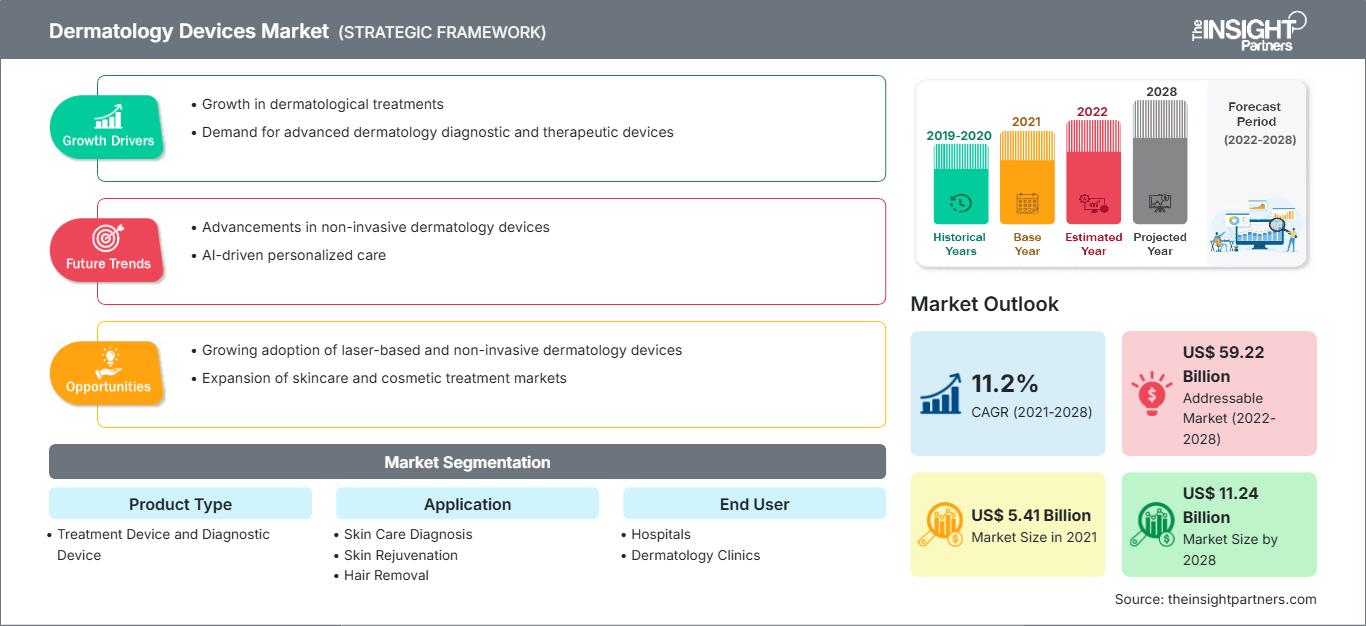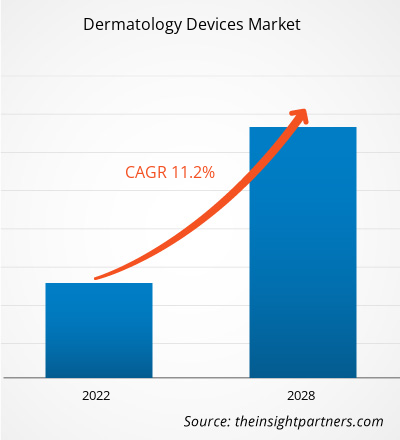Il mercato globale dei dispositivi dermatologici è stato valutato a 5.408,57 milioni di dollari nel 2021; si stima che crescerà a un CAGR dell'11,2% dal 2022 al 2028.
Il rapporto evidenzia le tendenze prevalenti nel mercato dei dispositivi dermatologici e i fattori che ne determinano la crescita. La dermatologia prevede l'uso di un'ampia gamma di dispositivi medici per l'esecuzione di procedure dermatologiche cosmetiche e mediche. I dispositivi dermatologici aiutano nella diagnosi e nel trattamento di vari disturbi della pelle, come il cancro della pelle e la psoriasi. Possono essere utilizzati anche per criochirurgia, terapia fotodinamica, chirurgia micrografica di Mohs, elettrodissecazione e curettage. La Food and Drug Administration (FDA) svolge un ruolo fondamentale nella regolamentazione, approvazione e sorveglianza post-marketing di questi dispositivi, garantendone la sicurezza e l'efficacia.
Il rapporto offre approfondimenti e un'analisi approfondita del mercato globale dei dispositivi dermatologici, evidenziando diversi parametri, tra cui tendenze di mercato, progressi tecnologici, dinamiche di mercato e analisi del panorama competitivo dei principali attori del mercato. Include anche l'impatto della pandemia di COVID-19 sul mercato in tutte le regioni. Il COVID-19 ha avuto un impatto complessivamente eterogeneo sul mercato globale dei dispositivi dermatologici. I sistemi sanitari sono stati sovraccaricati da questa crisi sanitaria globale e l'erogazione di assistenza medica a tutti i pazienti è diventata una sfida fondamentale in molte regioni. Inoltre, con l'avanzare della pandemia di COVID-19, le aziende produttrici di dispositivi medici hanno riscontrato difficoltà nella gestione delle proprie attività. Molti produttori di dispositivi dermatologici con attività commerciali negli Stati Uniti sono stati colpiti negativamente dalla diffusa epidemia. Tuttavia, dopo che le restrizioni dovute alla pandemia sono state allentate in risposta al calo del numero di casi, il numero di procedure estetiche eseguite dai dermatologi è tornato alla normalità, poiché gli ospedali hanno iniziato a riprendere le procedure elettive, incrementando così la domanda di dispositivi dermatologici.
Personalizza questo rapporto in base alle tue esigenze
Potrai personalizzare gratuitamente qualsiasi rapporto, comprese parti di questo rapporto, o analisi a livello di paese, pacchetto dati Excel, oltre a usufruire di grandi offerte e sconti per start-up e università
Mercato dei dispositivi dermatologici: Approfondimenti strategici

- Ottieni le principali tendenze chiave del mercato di questo rapporto.Questo campione GRATUITO includerà l'analisi dei dati, che vanno dalle tendenze di mercato alle stime e alle previsioni.
Potrai personalizzare gratuitamente qualsiasi rapporto, comprese parti di questo rapporto, o analisi a livello di paese, pacchetto dati Excel, oltre a usufruire di grandi offerte e sconti per start-up e università
Mercato dei dispositivi dermatologici: Approfondimenti strategici

- Ottieni le principali tendenze chiave del mercato di questo rapporto.Questo campione GRATUITO includerà l'analisi dei dati, che vanno dalle tendenze di mercato alle stime e alle previsioni.
Mercato dei dispositivi dermatologici - Approfondimenti basati sulla geografia
Per area geografica, il mercato globale dei dispositivi dermatologici è segmentato in Nord America (Stati Uniti, Canada e Messico), Europa (Germania, Regno Unito, Francia, Italia, Spagna e resto d'Europa), Asia Pacifico (Cina, Giappone, India, Corea del Sud, Australia e resto dell'APAC), America meridionale e centrale (Brasile, Argentina e resto dell'America meridionale e centrale) e Medio Oriente e Africa (Arabia Saudita, Sudafrica, Emirati Arabi Uniti e resto del Medio Oriente e Africa).
Approfondimenti di mercato
Crescente prevalenza di tumori e disturbi della pelle
Secondo il rapporto dell'American Academy of Dermatology Association (AAD), il tumore della pelle è il tipo di cancro più diffuso negli Stati Uniti. A titolo di cronaca, si stima che negli Stati Uniti ogni giorno vengano diagnosticati più di 9.500 tumori della pelle. La maggior parte dei tumori della pelle sono tumori cutanei non melanoma (NMSC), che colpiscono oltre 3 milioni di americani ogni anno. Tra questi, le donne hanno registrato i tassi di incidenza più elevati per i NMSC, con un aumento dei tassi tra la popolazione più giovane. Il costo annuo del trattamento dei tumori della pelle negli Stati Uniti è stimato in 1,8 miliardi di dollari, 4,8 miliardi di dollari per i NMSC e 3,3 miliardi di dollari per il melanoma. Inoltre, il rapporto di Frontiers SA afferma che la prevalenza del tumore della pelle è una tendenza globale. La biopsia cutanea e la valutazione istopatologica sono essenziali per confermare la diagnosi di tumore della pelle. Ad esempio, lo sviluppo di tecnologie, metodi e dispositivi di imaging destinati alla registrazione e all'analisi ha fatto rapidi progressi. I dispositivi di imaging dermoscopico irradiano la luce sullo strato dermico superiore per osservare e registrare dettagliate alterazioni della pigmentazione. Inoltre, lo sviluppo di dispositivi diagnostici non invasivi ad alta risoluzione, come la microscopia confocale e la microscopia multifotonica, in grado di rilevare i livelli cellulari delle lesioni cutanee senza biopsia, è stato ampiamente accettato sul mercato. Tali sviluppi innovativi contribuiscono efficacemente alla diagnosi del cancro della pelle, alla lettura accurata delle alterazioni nelle lesioni sospette e all'efficacia della chirurgia di follow-up per il cancro della pelle.
Le patologie cutanee rappresentano un problema importante a livello globale tra adolescenti e adulti. Acne, psoriasi e rosacea sono tra le patologie cutanee più comuni nella popolazione. Per quanto riguarda i dati, l'acne è la patologia cutanea più comune che colpisce fino a 50 milioni di americani ogni anno, secondo le stime fornite dall'AAD. Inoltre, circa 7,5 milioni di persone negli Stati Uniti soffrono di psoriasi, che si riscontra principalmente tra gli adulti, con la percentuale più alta tra i 45 e i 64 anni. Infine, la rosacea è una malattia cutanea comune che colpisce 16 milioni di americani ogni anno, secondo il rapporto pubblicato dall'AAD. La diagnosi di tali patologie cutanee può essere effettuata efficacemente utilizzando l'Intelligenza Artificiale (IA). Tali fattori offrirebbero opportunità redditizie per il mercato globale dei dispositivi dermatologici nel periodo 2022-2028.
Mercato dei dispositivi dermatologici - Approfondimenti basati sui prodotti
In base alla tipologia di prodotto, il mercato globale dei dispositivi dermatologici è segmentato in dispositivi di trattamento e dispositivi diagnostici. Il segmento dei dispositivi di trattamento ha detenuto una quota di mercato maggiore nel 2021.
Mercato dei dispositivi dermatologici - Approfondimenti basati sulle applicazioni
In base all'applicazione, il mercato globale dei dispositivi dermatologici è segmentato in diagnosi del cancro della pelle, ringiovanimento cutaneo, epilazione, rimodellamento del corpo e rassodamento della pelle, psoriasi e altri. Il segmento della diagnosi del cancro della pelle ha detenuto la quota di mercato maggiore nel 2021.
Approfondimenti regionali sul mercato dei dispositivi dermatologici
Le tendenze regionali e i fattori che influenzano il mercato dei dispositivi dermatologici durante il periodo di previsione sono stati ampiamente spiegati dagli analisti di The Insight Partners. Questa sezione illustra anche i segmenti e la geografia del mercato dei dispositivi dermatologici in Nord America, Europa, Asia-Pacifico, Medio Oriente e Africa, America meridionale e centrale.
Ambito del rapporto di mercato sui dispositivi dermatologici
| Attributo del rapporto | Dettagli |
|---|---|
| Dimensioni del mercato in 2021 | US$ 5.41 Billion |
| Dimensioni del mercato per 2028 | US$ 11.24 Billion |
| CAGR globale (2021 - 2028) | 11.2% |
| Dati storici | 2019-2020 |
| Periodo di previsione | 2022-2028 |
| Segmenti coperti |
By Tipo di prodotto
|
| Regioni e paesi coperti | Nord America
|
| Leader di mercato e profili aziendali chiave |
|
Densità degli operatori del mercato dei dispositivi dermatologici: comprendere il suo impatto sulle dinamiche aziendali
Il mercato dei dispositivi dermatologici è in rapida crescita, trainato dalla crescente domanda degli utenti finali, dovuta a fattori quali l'evoluzione delle preferenze dei consumatori, i progressi tecnologici e una maggiore consapevolezza dei benefici del prodotto. Con l'aumento della domanda, le aziende stanno ampliando la propria offerta, innovando per soddisfare le esigenze dei consumatori e sfruttando le tendenze emergenti, alimentando ulteriormente la crescita del mercato.

- Ottieni il Mercato dei dispositivi dermatologici Panoramica dei principali attori chiave
Mercato dei dispositivi dermatologici - Approfondimenti basati sugli utenti finali
In base agli utenti finali, il mercato globale dei dispositivi dermatologici è segmentato in ospedali, cliniche dermatologiche e altri. Il segmento ospedaliero ha detenuto la quota di mercato maggiore nel 2021. Tuttavia, si prevede che il segmento delle cliniche dermatologiche crescerà al CAGR più elevato tra il 2022 e il 2028.
Alma Lasers (Sisram Medical), Cutera Inc., Candela Corporation, Solta Medical (Bausch Health Companies Inc.), FotoFinder Systems, Cynosure, Lumenis, El.En SpA, Leica Microsystem, Aerolase Corp. sono tra i principali attori del mercato globale dei dispositivi dermatologici. Questi attori del mercato hanno adottato strategie organiche, tra cui il lancio e l'espansione di prodotti, per espandere la propria presenza e il proprio portafoglio prodotti in tutto il mondo.
- Analisi storica (2 anni), anno base, previsione (7 anni) con CAGR
- Analisi PEST e SWOT
- Valore/volume delle dimensioni del mercato - Globale, Regionale, Nazionale
- Industria e panorama competitivo
- Set di dati Excel
Report recenti
Testimonianze
Motivo dell'acquisto
- Processo decisionale informato
- Comprensione delle dinamiche di mercato
- Analisi competitiva
- Analisi dei clienti
- Previsioni di mercato
- Mitigazione del rischio
- Pianificazione strategica
- Giustificazione degli investimenti
- Identificazione dei mercati emergenti
- Miglioramento delle strategie di marketing
- Aumento dell'efficienza operativa
- Allineamento alle tendenze normative






















 Ottieni un campione gratuito per - Mercato dei dispositivi dermatologici
Ottieni un campione gratuito per - Mercato dei dispositivi dermatologici